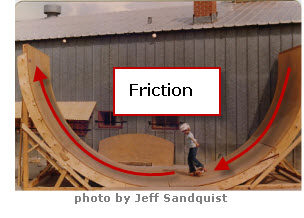 The Italian scientist Galileo Galilei (1564-1642) reasoned that things eventually stop because of a retarding force. He thought that without this force, objects just kept on doing whatever they were doing. In other words, if an object is moving, it would keep on moving.
The Italian scientist Galileo Galilei (1564-1642) reasoned that things eventually stop because of a retarding force. He thought that without this force, objects just kept on doing whatever they were doing. In other words, if an object is moving, it would keep on moving.
Unlike most scientists of his day, Galileo based his conclusions on experiments. Using a U-shaped path, Galileo released a ball at the top of one side, the ball rolled down the sloping path, and then up the opposite sloping side. This U-shaped track was shaped much like half pipes used by skateboarders today.
The ball in Galileo’s experiment continued to roll back and forth, but its height decreased. Galileo reasoned that a retarding force slowed the motion of the ball until it finally stopped. Galileo’s retarding force is now called friction.
DISCOVER FOR YOURSELF
Repeat Galileo’s experiment. For simple instructions as well as formation about gravity, acceleration, inertia, and friction, see PHYSICS: FRICTION 